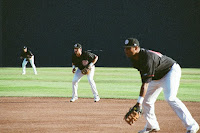Hitting for Average - Being able to consistently make solid contact in order to hit for a high batting average. One quick statistical measure of this tool is batting average, but scouts also look at your walks vs. strikeouts. My college coach always told us to aim to draw more walks than strikeouts. Anything close to a 1:1 walk to strikeout ratio is good. Scouts will also look for the ability to know the strike zone and not chase pitches that are out of the zone.
Hitting for Power - Having the ability to drive the ball to all parts of the field consistently. This is usually an easier tool to measure by looking at home runs and extra base hits. Scouts will also look at bat speed, physical body strength, and the velocity of the ball coming off the bat. They will often project someones power potential based on their physical build. I have also heard that scouts measure someones potential power by how high the ball goes on a pop-up or fly ball. People with a lot of power tend to hit higher fly balls.
 |
| Ready fielding positions |
Arm Strength - Having superior arm strength will allow you to make plays that others simply can not. This can be easily measured by throwing velocity. Having a strong arm will help infielders make long throws to first base, catchers throw out stealing base runners, and outfielders throw out a runner trying to score, or take an extra base. I also include throwing accuracy and consistency in this tool.
Running Speed - This tool is commonly measured by running a 60-yard dash. This is often regarded as the tool that is hardest to teach. Having excellent speed will help a player in almost every aspect of the game. For high school players, aim for a 60-yard time of 7.0. College players with plus speed will run a 6.8 or faster. Major leaguers that run 6.6 or better are considered fast, but the average Major League 60-yard time is rumored to be around 6.9-7.0 seconds.
 |
| Hustling off the field |
Now, don't panic if you don't have all of these tools because there are only a handful of guys in the world who are superior in every tool. My advice to anyone looking to improve their tools is to master the tool(s) that you possess. If you hit for average, work to increase your batting average and get on base more. Most importantly, don't try to be a player that you are not. The type of player that you are should match the tool set that you have. For example, I am not a guy who hits for power, so it would be foolish for me to have the same batting approach as Alex Rodriguez.
No comments:
Post a Comment